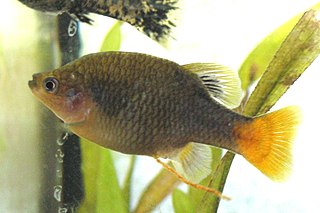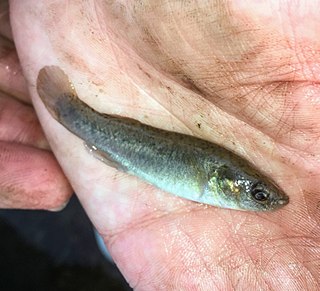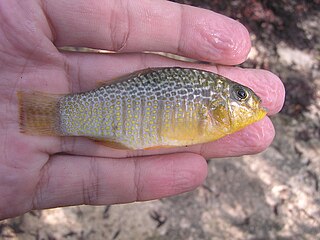
Goodeidae is a family of teleost fish endemic to Mexico and some areas of the United States. Many species are known as splitfins. This family contains about 50 species within 18 genera. The family is named after ichthyologist George Brown Goode (1851-1896).

The White River springfish is a species of fish in the family Goodeidae, the splitfins. It is a rare species of the Great Basin of western United States, where it is endemic to isolated warm springs in the White River drainage of eastern Nevada.
The Parras characodon is a species of goodeid fish once endemic to Coahuila, Mexico. Its natural habitats were destroyed between 1900 and 1953, and no records have been made in the last century; it is considered extinct, although the validity of this taxon and where the actual type locality is are subject to some doubt. The specific name honours the American herpetologist and ichthyologist Samuel Garman (1843–1927).
The striped goodeid, bluetail goodeid or bluetail goodea is an endangered species of fish in the family Goodeidae. Its genus Ataeniobius is monotypic. It is endemic to the Río Verde and associated waters, including the Media Luna and Los Anteojitos lakes, in San Luis Potosí, Mexico. The specific name of this fish honours its discoverer, the America evolutionary biologist William Lawrence Tower (1872–1955) of the University of Chicago.

The Highland splitfin is a species of splitfin endemic to Mexico where it is found in the Lerma River basin. This species grows to a length of 5 centimetres (2.0 in) TL. It is the only known member of its genus, although some authorities have Hubbina as a subgenus of Girardinichthys and add Girardinichthys ireneae to the subgenus, even treating this taxon as a synonym of G. ireneae. This species was described by Don Fernando de Buen y Lozano in 1940 with the type locality given as Cointzio, Michoacán. The name of the genus honours the American ichthyologist Carl Leavitt Hubbs (1894-1979) while the specific name honours Clarence Lester Turner (1890-1969), thus honouring two ichthyologists who worked on a review of the Goodeidae in 1939.

The Balsas splitfin is a species of fish in the family Goodeidae. It is endemic to Mexico where it occurs in the states of Morelos and Michoacán. This fish was formally described as Goodea whitei by Seth Eugene Meek in 1904 with the type locality given as Yautepec in Morelos. The specific name honours E. A. White of the Interoceanic Railway of Mexico for his interest in and support of Meek's work.

The saltmarsh topminnow is a species of killifish for the family Fundulidae. It occurs in the costal wetlands of the Gulf of Mexico in the United States.

Cubanichthys is a small genus of pupfishes endemic to the Caribbean Islands of Cuba and Jamaica. The name of this genus is a compound of Cuba, where the genus was thought to be endemic until C. pengellyi was placed in the genus, and the Greek word for fish, ichthys.

Floridichthys is a genus of pupfishes native to the southeastern United States, Mexico and northern Central America. The name of this genus is a compound of Florida and the Greek for "fish", ichthys. The ichthyologist Carl Leavitt Hubbs thought that the genus was confined to Florida at the time he coined the name.
The Yucatan flagfish, also known as the snakeskin killifish, is a species of pupfish from the family Cyprinodontidae. It is found in the coastal waters of the Yucatan Peninsula, in Mexico and Belize. This species grows to a length of 4 centimetres (1.6 in) TL and is found in the aquarium trade. This species was described by Carl Leavitt Hubbs in 1936 with the type locality given as 5 kilometres (3.1 mi) east of Progreso, Yucatán, Mexico. It is the only known member of its genus. The name of the genus commemorates the American ichthyologist Samuel Garman (1843-1927) who was working on a revision of his 1895 monograph on the Cyprinodontidae at the time of his death. It is sometimes treated as a junior synonym of Jordanella.

Aphanius danfordii, the Kızılırmak toothcarp or Sultan Sazlığı toothcarp, is a species of killifish belonging to the family Cyprinodontidae. It is endemic to the Kızılırmak River and the upper Seyhan River drainage systems and is now restricted to a few locations in the Sultan Sazlığı marshes. Though little data is available, the population of the fish seems to be declining. The International Union for Conservation of Nature has rated its conservation status as being "critically endangered" and fears it may become extinct in the wild if the drainage of the marshes continues.

Lucania goodei, the bluefin killifish, is a small species of fish in the topminnow family Fundulidae. It is native to the southeastern United States, but has been introduced to California, Texas and North Carolina. Other common names for the fish include Florida blue dace.

Mucurilebias leitaoi is a species of rivulid killifish endemic to Brazil where it occurs, or formerly occurred, in the basin of the Mucuri River. This species can reach a length of 3 centimetres (1.2 in) TL. This species has not been seen since the original series of types was collected in 1988 and it may have become extinct due to the extensive habitat loss in the region. This species is the only known member of its genus, but it was formerly included in Leptolebias. The specific name of this fish honours the Brazilian ichthyologist and herpetologist Antenor Leitão de Carvalho (1910-1985).
The Dead Sea toothcarp is a subspecies of the Arabian toothcarp that is endemic to the Dead Sea basin, although molecular evidence suggests that it should be regarded as a species. It is threatened by water fluctuation, and the introduction of cichlids and Gambusia. The sub-specific name of this fish honours the Scottish surgeon and naturalist John Richardson (naturalist) (1787-1865) who first reported killifish in the Dead Sea basin. The Dead Sea toothcarp -- has been on the red list of the International Union for Conversation of Nature since 2014.

Tlaloc is a genus of fish in the family Profundulidae endemic to Mexico, Guatemala and Honduras. The genus is not, however, recognised by Fishbase or in the 5th Edition of Fishes of the World. The genus is named for Tlaloc the water god of the Aztecs.

The Seminole killifish is a fish of the genus Fundulus, endemic to the U.S. state of Florida.

Goodea luitpoldii, the green goodea, is a species of killifish from the family Goodeidae which is endemic to the drainage basin of the Lerma River and the Grande de Santiago River in Mexico. This species was Species description described as Characodon luitpoldii by the Franz Steindachner in 1894 with the type locality given as Lake Pátzcuaro in Michoacán. The identity of the person honoured in its specific name is unknown but it is thought likely to be Luitpold, Prince Regent of Bavaria (1821-1912) whose daughter, Princess Therese of Bavaria (1850-1925) was an explorer and amateur naturalist and she collected the type.
Valencia robertae is a species of Mediterranean killifish, from the family Valenciidae. It is endemic to Greece where it is found in the Lower Pinios and lower Mornos Rivers in Greece. The species was described in 2004 with the type locality given as River Pinios south of Kavasila. The specific name honours the Italian ichthyologist Roberta Barbieri of the Hellenic Centre for Marine Research in Athens.
Cubanichthys pengelleyi, the Jamaican killifish, is a species of killifish from the family Cyprinodontidae, the pupfishes, which is endemic to Jamaica. It is found in shallow, crystal clear waters with a depth of 1.5 metres (4.9 ft) and a pH of 8.2). These have a substrate consisting mainly of sand with some softer patches of silt. This species hides among aquatic vegetation. Its prey consists of damselfly and dragonfly larvae, the larvae of other aquatic insects, ostracods, copepods and snails. The specific name honours the Jamaican physician and medical officer Charles Edward Pengelley (1888–1966) who obtained the type.
Epiplatys grahami is a species of fish in the family Nothobranchiidae, an African rivuline, which is native to the fresh water habitats in southeastern Benin, through southern Nigeria and Cameroon, to northwestern Equatorial Guinea. This species reaches a length of 7.0 cm (2.8 in).














